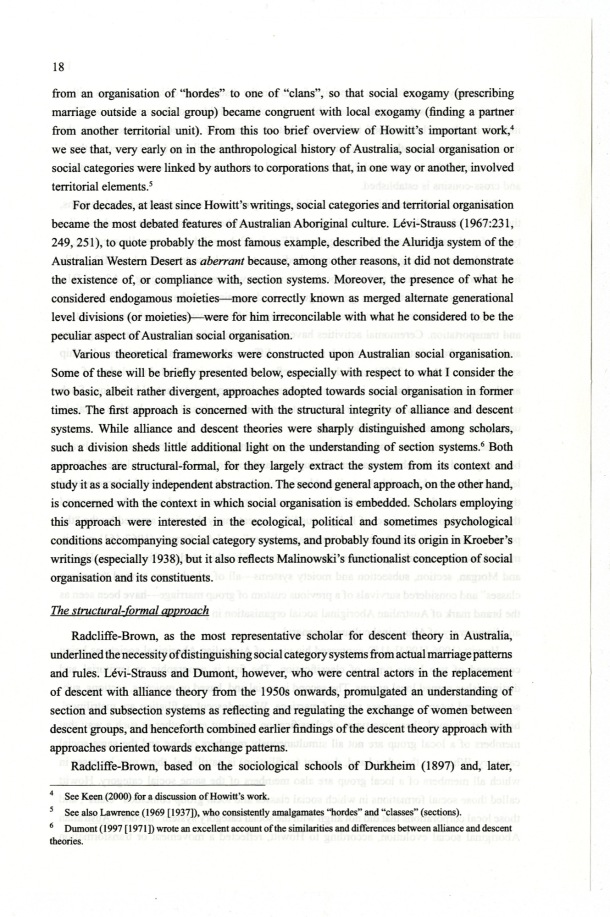|
| 
[Note: this transcription was produced by an automatic OCR engine]
18
from an organisation of “hordes" to one of “clans”, so that social exogamy prescribing
marriage outside a social group became congruent with local exogamy finding a partner
from another territorial unit. From this too brief overview of Howitt’s important work,‘
we see that, very early on in the anthropological history of Australia, social organisation or
social categories were linked by authors to corporations that, in one way or another, involved
territorial elements.5
For decades, at least since Howitt’s writings, social categories and territorial organisation
became the most debated features of Australian Aboriginal culture. Lévi-Strauss l967:231,
249, 251, to quote probably the most famous example, described the Aluridja system of the
Australian Western Desert as aberrant because, among other reasons, it did not demonstrate
the existence of, or compliance with, section systems. Moreover, the presence of what he
considered endogarnous moieties—more correctly known as merged alternate generational
level divisions or moieties—were for him irreconcilable with what he considered to be the
peculiar aspect of Australian social organisation.
Various theoretical frameworks were constructed upon Australian social organisation.
Some of these will be briefly presented below, especially with respect to what I consider the
two basic, albeit rather divergent, approaches adopted towards social organisation in former
times. The first approach is concerned with the structural integrity of alliance and descent
systems. While alliance and descent theories were sharply distinguished among scholars,
such a division sheds little additional light on the understanding of section systems.‘ Both
approaches are structural-formal, for they largely extract the system from its context and
study it as a socially independent abstraction. The second general approach, on the other hand,
is concerned with the context in which social organisation is embedded. Scholars employing
this approach were interested in the ecological, political and sometimes psychological
conditions accompanying social category systems, and probably found its origin in Kroeber’s
writings especially 1938, but it also reflects Ma1inowski’s functionalist conception of social
organisation and its constituents.
1719 structuraI- armal mach
Radcliffe-Brown, as the most representative scholar for descent theory in Australia,
underlined the necessity of distinguishing social category systems from actual marriage patterns
and rules. Lévi-Strauss and Durnont, however, who were central actors in the replacement
of descent with alliance theory from the 1950s onwards, promulgated an understanding of
section and subsection systems as reflecting and regulating the exchange of women between
descent groups, and henceforth combined earlier findings of the descent theory approach with
approaches oriented towards exchange patterns.
Radclitfe-Brown, based on the sociological schools of Durkheim 1897 and, later,
4 See Keen 2000 for a discussion of Howiu’s work.
5 See also Lawrence 1969 [l937]lt who consistently amalgarnates “hordes” and “classes” sections.
6 Durnont 1997 [197] ] wrote an excellent account of the similarities and differences between alliance and descent
theories.
|